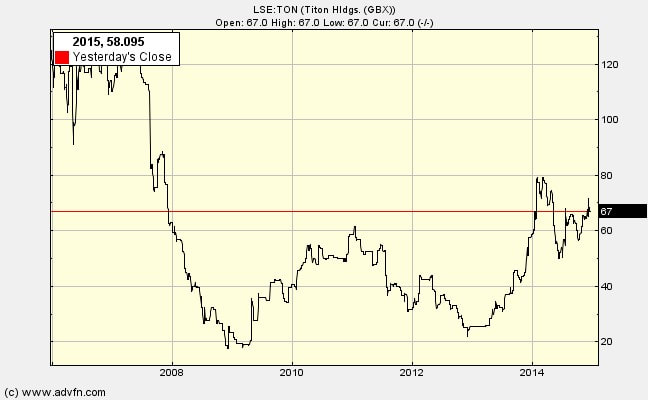|
A couple of weeks ago Titon report stunningly good annual results (preliminaries) for the year ended 30th September. For a company with a MCap of £7.2m to report after-tax profits of £1.28m is great (revenues up 22% at £19.3m). Furthermore, there are good reasons to believe that this is not a one-off. The UK side of the business has still not recovered from the recession, and, more particularly, the government still restrict public sector house building, and so the company still only reports ‘a small profit’ for the UK.
It is the Korean business that is going great guns; with only 30% of Titon’s turnover it produces almost 100% of the profit. An accounting lesson However, this is only half the story. To really understand Titon you need to get into the accounting rules for ‘subsidiaries’ and ‘associates’ Hey you! wake up at the back of the class! Now begins our accounting lesson. Are you ready? (At least this is how I understand the company set-up, from the information I have available – if you know something else please tell us). In the beginning……, or at least in 2008…… Titon entered the Korean market. It set up a subsidiary, imaginatively called Titon Korea, in which it held 51% of the shares and managerial control. The rules for subsidiaries are that 100% of the assets, liabilities, profits, etc., are all consolidated in the Group accounts at the end of the year. So they are all lumped-in together even though Titon Parent only has an economic interest in 51%. To allow for the bit of profit, or the bit of net assets, attributable to the 49% shareholders the consolidated accounts include a deduction for ‘Non-controlling interests’; In the case of Titon Korea I understand these people to be ‘Korean investors’. Are you with me so far? Stop slouching then! Here it gets a little more complicated….but not too much, don’t worry. Titon set up, together with some ‘Korean investors’ (perhaps the same lot), another company, Browntech. This is not a subsidiary because Titon only controls 49% and does not have managerial control – it’s ‘Korean partners’ have managerial control. Browntech is therefore an ‘associate’. The assets, liabilities and profits are not consolidated into the Group accounts. Rather, a share of the profits, in this case 49% of the annual profits go into the Group accounts. Thus, you will find a separate line in the accounts called ‘Share of profit/(losses) from Associate’. For 2014 this was £181,000, whereas in 2013 it was £262,000. As I understand it, the subsidiary, Titon Korea, manufactures or imports from the UK. It then sells to Browntech which does the marketing to Korean customers. I have some numbers for 2013: Titon Korea sold £3.68m of goods to Browntech (double the previous year). Browntech had revenues of £5.62m – so Browntech has quite good mark-up. But it must also have a lot of expenses, because it only made profits of twice £262,000. All I have for 2014 is Titon Korea sales of £5.66m (not Browntech sales numbers). But note the rapid rise. Sales for Titon Korea have risen from £1.9m in 2012 to £5.66m two years later. Stunning! The Korean investors must be pleased they teamed up with Titon; and so are Titon’s shareholders. I’m surmising here, but, if the overall profit was £1.28m for 2014 and the UK profit was so small as to not be mentionable and the profit from selling in other countries (on revenue of around £2m) was also negligible, then the subsidiary in Korea must have made around £1.1m profit (because the ‘Associate’ made the other £188,000). Here endeth the accounting lesson. Are you still awake? In Monday's newsletter I'll look at the prospects for the UK business and examine the Korean business in more detail.
0 Comments
Leave a Reply. |
Archive
I wrote newsletters for almost 10 years (2014 - 23) for publication on ADVFN. Here you can find old newsletters in full. I discussed investment decisions, basics of value investing and the strategies of legendary investors. Archives
October 2020
Categories |

 RSS Feed
RSS Feed